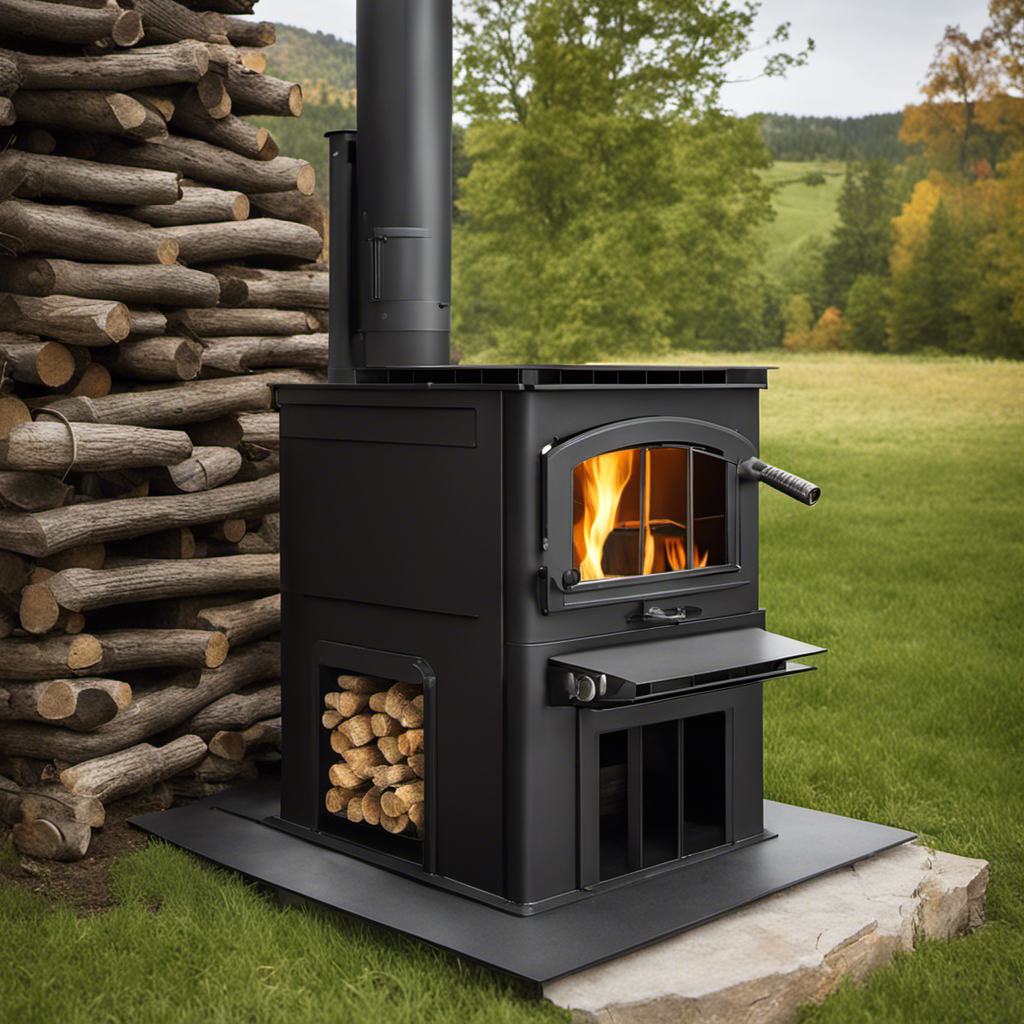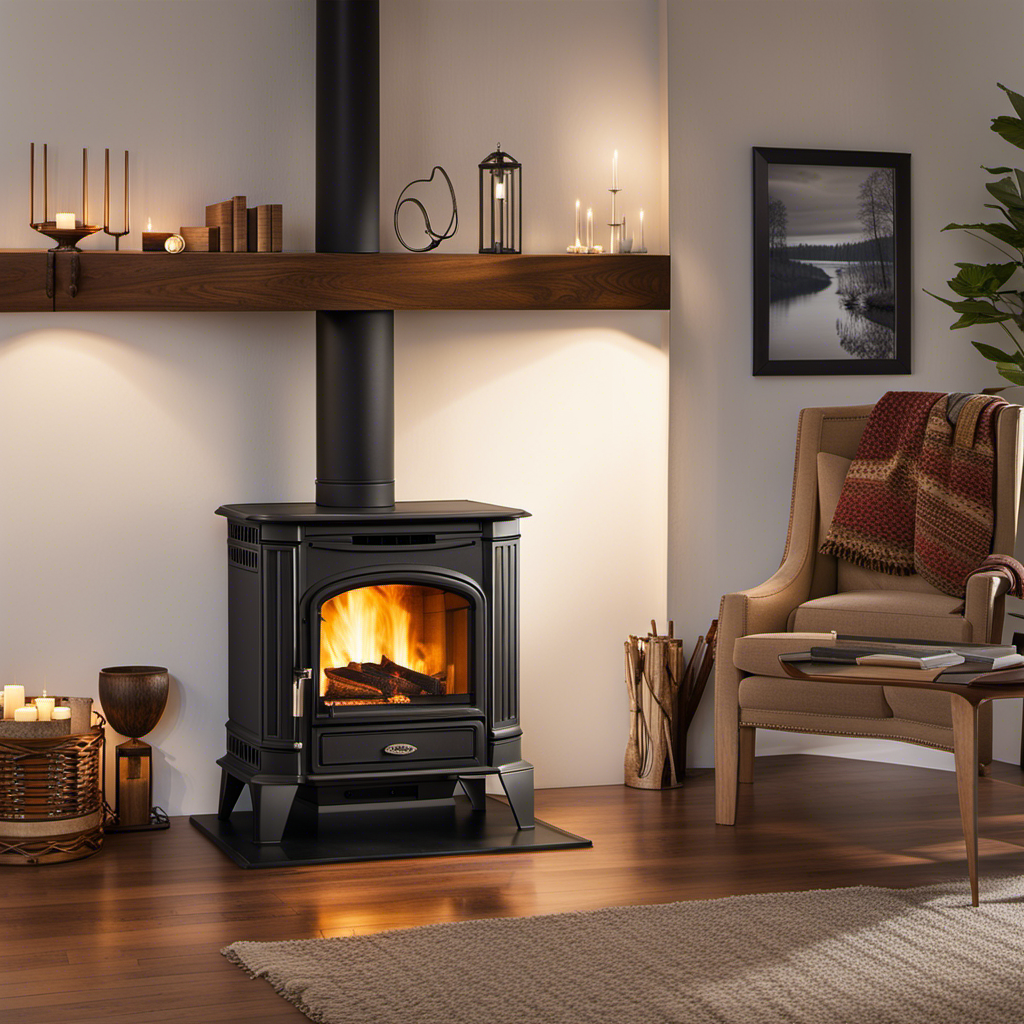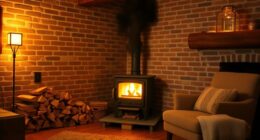As the popular adage implies, “Where there’s a grill, there’s a way.” And honestly, when it comes to using wood pellet grills in the winter, there really isn’t a better way to satisfy your grilling cravings.
I’ve personally experienced the benefits of using these grills during the colder months, and let me assure you, they deliver exceptional performance even in cold temperatures.
In this article, I’ll share tips for maintaining temperature control, mouthwatering winter grilling recipes, comparisons with other grill types, and much more.
Get ready to elevate your winter grilling game with wood pellet grills!
Key Takeaways
- Wood pellet grills perform well in freezing temperatures due to insulation and wind resistance features.
- The smoky flavor of wood pellet grills enhances dishes and adds depth to winter cooking.
- Proper maintenance and use of winter grilling accessories help maintain temperature control in cold weather.
- Efficient fuel consumption and digital temperature control make wood pellet grills well-equipped for winter cooking challenges.
Benefits of Using Wood Pellet Grills in Winter
Wood pellet grills are great for cooking in the winter because they maintain a consistent temperature and provide a smoky flavor to your food. When it comes to cold weather grilling, these grills have some unique benefits.
First, the consistent temperature control allows you to cook your food evenly, even in freezing temperatures. You don’t have to worry about fluctuating temperatures affecting the outcome of your dishes.
Second, the smoky flavor that wood pellet grills provide adds an extra depth to your winter cooking. Whether you’re grilling meats, vegetables, or even baking desserts, the smoky aroma and taste will enhance your dishes and make them even more enjoyable.
Now, let’s talk about the performance of wood pellet grills in cold temperatures and how they can withstand the challenges of winter cooking.
Performance of Wood Pellet Grills in Cold Temperatures
Despite the colder temperatures, wood pellet grills can still maintain consistent heat output. This is due to several factors that help them perform well even in winter conditions:
-
Insulation: Wood pellet grills that are properly insulated retain heat more efficiently, ensuring consistent temperatures throughout the cooking process.
-
Wind resistance: Wind can have a significant impact on grill performance in winter. Wood pellet grills with built-in wind shields or those placed in a sheltered area are less affected by gusts, allowing for better heat retention.
-
Efficient fuel consumption: Wood pellet grills are designed to use pellets as fuel, which burn consistently and efficiently, even in cold weather.
-
Digital temperature control: Most wood pellet grills come with digital temperature control, allowing you to easily adjust and maintain the desired heat level, regardless of the outside conditions.
With these features, wood pellet grills are well-equipped to handle winter cooking. However, maintaining temperature control in colder temperatures requires some additional considerations and techniques.
Tips for Maintaining Temperature Control in Winter
To maintain consistent temperature control during winter cooking, you’ll want to make sure your wood pellet grill is properly insulated and protected from the elements. One of the first tips for maintaining temperature control is to clean your grill regularly. A buildup of grease and debris can affect the airflow and temperature distribution inside the grill. Use a grill brush to remove any residue from the grates and clean the drip tray to prevent flare-ups.
Additionally, consider investing in winter grilling accessories such as grill blankets or thermal covers. These accessories can help retain heat and minimize heat loss during cold weather conditions. By keeping your grill clean and using the right accessories, you’ll be better equipped to maintain consistent temperature control for your winter grilling adventures.
Now, let’s move on to some delicious winter grilling recipes for wood pellet grills.
Winter Grilling Recipes for Wood Pellet Grills
When it comes to grilling in winter, there are a few key points to consider: heat distribution, cold weather pellet storage, and winter grilling safety.
In colder temperatures, it’s important to ensure that your grill maintains an even heat distribution to achieve perfectly cooked meals.
Additionally, storing your pellets properly in cold weather will ensure their quality and performance when grilling.
Lastly, practicing winter grilling safety measures, such as keeping your grill away from flammable materials and using proper insulation, will help you enjoy your grilling experience without any accidents.
Heat Distribution in Winter
In the winter, you’ll notice that wood pellet grills distribute heat evenly. This is due to their efficient design and advanced technology. Wood pellet grills are equipped with a fan and a thermostat that regulate the temperature, ensuring consistent heat distribution. The pellets are fed into the fire pot where they ignite and produce heat. The heat is then circulated throughout the grill, cooking your food evenly and thoroughly.
This is especially important in the winter when maintaining heat retention is crucial for successful grilling. To enhance heat retention, you can use techniques such as preheating the grill for a longer period of time, using insulated blankets or covers, and minimizing the opening of the lid. These winter grilling techniques will help you achieve delicious results even in cold weather.
Speaking of cold weather, let’s now discuss cold weather pellet storage and the importance of proper storage techniques.
Cold Weather Pellet Storage
When it comes to using wood pellet grills during the winter, proper cold weather pellet storage is crucial. Cold temperatures can affect the quality and performance of wood pellets, so it’s important to store them correctly to ensure optimal results for winter grilling techniques.
Here are some key points to keep in mind:
-
Dry and Sealed Storage: Store your wood pellets in a dry and sealed container to prevent moisture absorption, which can lead to clumping and poor combustion. Use airtight plastic containers or moisture-resistant bags to keep the pellets dry. Avoid storing them directly on the ground to prevent moisture seepage.
-
Temperature Control: Maintain a consistent temperature in the storage area to protect the pellets from extreme cold or heat. Keep the storage area insulated to prevent temperature fluctuations. Avoid exposing the pellets to direct sunlight or freezing temperatures.
With proper cold weather pellet storage, you can ensure that your wood pellets remain in excellent condition, allowing you to enjoy the benefits of wood pellet grilling even during the winter months.
Now, let’s move on to the next section about winter grilling safety.
Winter Grilling Safety
Proper cold weather pellet storage is crucial for safe winter grilling. It’s important to ensure that your equipment is in good working condition when it comes to winter grilling. Before firing up your wood pellet grill, make sure to check all the components, such as the ignition system and temperature controls. It’s also essential to clean the grill thoroughly to remove any debris or grease buildup. Additionally, consider using a grill cover to protect your grill from the elements.
When it comes to grilling techniques, be mindful of the colder temperatures and adjust your cooking times accordingly. Remember to preheat your grill for a longer period to ensure consistent heat.
Now let’s explore how wood pellet grills compare to other types in winter, without skipping a beat.
Comparing Wood Pellet Grills to Other Types in Winter
When it comes to winter grilling, wood pellet grills offer several advantages.
Firstly, their temperature control is exceptional, allowing for precise cooking even in cold weather.
Additionally, pellet grills are highly fuel efficient, ensuring that you can grill for extended periods without worrying about running out of fuel.
Winter Grilling Advantages
One of the advantages of grilling with a wood pellet grill in the winter is that it provides consistent heat. Having equipment that can maintain a steady temperature is crucial for winter grilling. Wood pellet grills are designed with advanced technology that allows for precise temperature control. This ensures that your food cooks evenly and to perfection. Unlike traditional charcoal grills, pellet grills have a built-in thermostat that regulates the temperature automatically. This eliminates the need for constant monitoring and adjustments, making winter grilling more convenient and hassle-free.
Additionally, wood pellet grills are highly versatile and can be used for a wide range of cooking methods, from smoking to baking. These grills have efficient heat distribution and reliable temperature control, making them a great choice for winter grilling enthusiasts.
As we delve into the topic of pellet grill temperature control, let’s explore the various features and techniques that contribute to achieving optimal grilling results.
Pellet Grill Temperature Control
To achieve consistent temperature control on your grill, you’ll want to familiarize yourself with the various settings and techniques available.
When it comes to pellet grill maintenance, it’s important to clean the grill regularly to ensure optimal performance. This includes removing any ash buildup in the fire pot and cleaning the grates and drip tray.
Additionally, during the winter months, there are specific grilling techniques that can help you maintain a steady temperature. One technique is to preheat your grill for a longer period of time to compensate for the colder ambient temperature. Another technique is to use a thermal blanket or insulation to retain heat.
By implementing these winter grilling techniques and properly maintaining your pellet grill, you can ensure consistent temperature control even in the coldest of months.
Speaking of temperature control, let’s now discuss fuel efficiency in winter without compromising the grilling experience.
Fuel Efficiency in Winter
Make sure you adjust the airflow and keep the lid closed tightly to maximize the fuel efficiency of your grill during the colder months. Winter grilling can be a challenge, but with the right techniques, you can minimize fuel consumption and still achieve delicious results. Here are some winter grilling techniques to help you save fuel and keep your grill running efficiently:
| Technique | Description | Benefits |
|---|---|---|
| Preheat the grill | Allow the grill to reach the desired temperature before placing the food on it. | Ensures even cooking and reduces cooking time. |
| Use insulated gloves | Insulated gloves will keep your hands warm and protected while grilling in cold weather. | Allows you to handle the grill and food comfortably. |
| Utilize a grill cover | A grill cover helps retain heat and protects the grill from the elements. | Prevents heat loss and extends the life of your grill. |
| Monitor the temperature | Keep an eye on the grill’s temperature to prevent excessive fuel consumption. | Allows you to make necessary adjustments for optimal cooking. |
| Choose the right fuel | Opt for high-quality pellets that burn efficiently and produce consistent heat. | Maximizes fuel efficiency and enhances flavor. |
Addressing Common Winter Grilling Challenges With Wood Pellet Grills
Addressing common winter grilling challenges with wood pellet grills, you’ll find that they excel in maintaining consistent temperatures despite colder weather conditions. This is crucial for maintaining the flavor profile of your dishes, as temperature fluctuations can affect the cooking process and result in unevenly cooked food.
Wood pellet grills are designed to handle cold temperatures and can easily maintain the desired temperature range, allowing you to achieve that perfect sear on your steak or smoke your ribs to perfection.
To enhance your winter grilling experience, there are a few techniques you can employ. For example, preheating the grill for longer and using insulation blankets to retain heat. These methods will help you conquer the challenges of winter grilling and continue enjoying delicious meals outdoors.
As you explore the benefits of wood pellet grills in winter, it’s essential to also consider the safety considerations for grilling in colder temperatures.
Safety Considerations for Grilling With Wood Pellet Grills in Winter
When it comes to grilling safety, there are a few key considerations to keep in mind, especially when using wood pellet grills in the winter.
First and foremost, it’s essential to ensure that your grill is placed on a stable and level surface to prevent any accidents.
Additionally, it’s crucial to keep your grill at a safe distance from any flammable materials, such as trees or buildings.
Another important aspect of grilling safety is to avoid leaving your grill unattended, especially in colder temperatures where there may be a higher risk of fire.
Finally, always make sure to follow the manufacturer’s guidelines for proper use and maintenance of your wood pellet grill.
Transitioning into the next section about extending the lifespan of wood pellet grills in winter, there are several steps you can take to protect your grill from the harsh winter conditions.
Extending the Lifespan of Wood Pellet Grills in Winter
To protect your grill from the harsh winter conditions, you’ll want to take several steps to extend its lifespan.
Winter can be tough on grills, but with the right techniques, you can keep yours in great shape.
First, make sure to clean your grill thoroughly before winter hits. This includes removing any grease or debris that may have accumulated during the grilling season.
Next, consider investing in a grill cover to protect it from snow, ice, and other elements. Additionally, storing your grill in a sheltered area, such as a garage or shed, can provide extra protection.
Lastly, regularly inspect your grill for any signs of damage or wear and tear, and address these issues promptly to prevent further damage.
Does the Cold Weather Affect the Performance of a Wood Pellet Grill?
Yes, cold weather does affect the performance of a wood pellet grill duration. In colder temperatures, the grill may struggle to reach and maintain the desired heat levels, resulting in longer cooking times. It’s important to take this into consideration when using a wood pellet grill in cooler climates.
Frequently Asked Questions
Can I Use My Wood Pellet Grill in Extreme Cold Temperatures?
I can definitely use my wood pellet grill in extreme cold temperatures. It has many benefits in the winter, such as consistent temperature control and the ability to smoke and grill delicious food all year round.
How Do Wood Pellet Grills Compare to Gas Grills in Terms of Performance in Winter?
In winter, wood pellet grills outperform gas grills. The steady heat and efficient insulation of wood pellet grills make them ideal for cold temperatures. The smoky flavor and versatility are added bonuses.
Are There Any Special Precautions I Need to Take When Using a Wood Pellet Grill in Winter?
When using a wood pellet grill in winter, it’s important to take precautions and perform winter maintenance. This ensures optimal performance and prevents damage caused by harsh weather conditions.
Can I Use My Wood Pellet Grill to Smoke Meats in Winter?
In the winter, I love using my wood pellet grill to smoke meats. Not only does it add a smoky flavor, but the consistent temperature control and insulation make it perfect for cold weather grilling.
What Are Some Common Maintenance Issues I Should Be Aware of When Using a Wood Pellet Grill in Winter?
Common maintenance issues when using a wood pellet grill in winter include potential pellet jams, decreased performance in cold temperatures, and increased ash accumulation. Here are some winter grilling tips to prevent these issues.
Conclusion
In conclusion, I must say that wood pellet grills are truly a game-changer in the winter. Not only do they provide deliciously smoky flavors, but they also perform exceptionally well in cold temperatures.
With some tips and tricks, you can easily maintain temperature control and enjoy winter grilling to the fullest. From mouthwatering recipes to addressing common challenges, these grills have got you covered.
Just remember to prioritize safety and take care of your grill to extend its lifespan. So go ahead, embrace the winter grilling season with a wood pellet grill and elevate your culinary experience.
Logan’s affair with adventure began in childhood. He hailed from a small town where vast forests bordered one side and endless shores stretched on the other. His days were spent exploring uncharted woods, climbing tall trees, or listening to the tales of old sailors. This early immersion in a world brimming with stories and mysteries became the foundation of his passion for writing.











